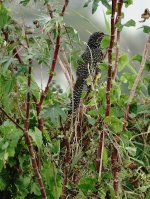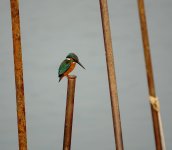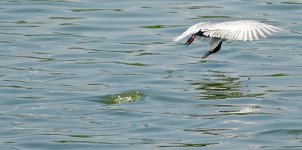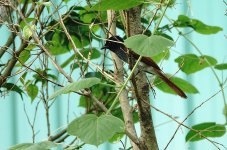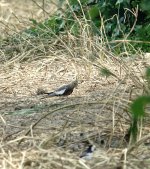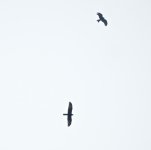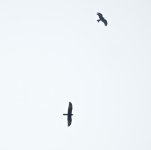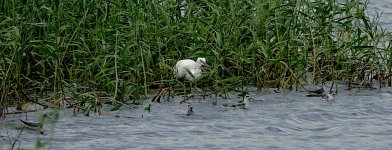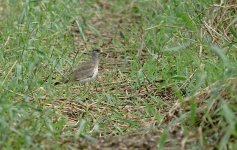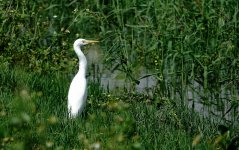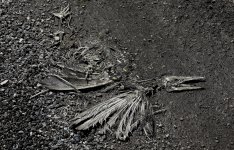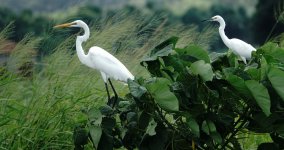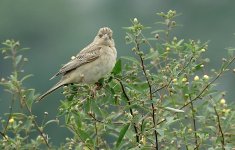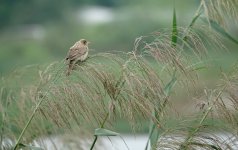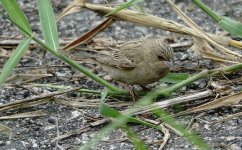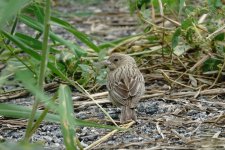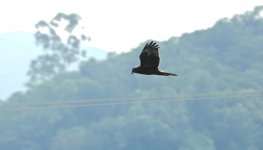-
Welcome to BirdForum, the internet's largest birding community with thousands of members from all over the world. The forums are dedicated to wild birds, birding, binoculars and equipment and all that goes with it.
Please register for an account to take part in the discussions in the forum, post your pictures in the gallery and more.
You are using an out of date browser. It may not display this or other websites correctly.
You should upgrade or use an alternative browser.
You should upgrade or use an alternative browser.
San Tin Fishponds (and beyond), Hong Kong (1 Viewer)
- Thread starter MKinHK
- Start date
More options
Who Replied?MKinHK
Mike Kilburn

Resident birds at San Tin
Many thanks for all the kind comments. I continue to cower on my sofa from the heat of a blistering May, but do have some shots of the commoner resident birds which i have not previously posted here.
First up, this newly fledged Plain Prinia jumped up right next me to in a stand of grass along one of the drainage channels. It's rare that I pay much attention to them as they are pretty common, but this one was not to be ignored and hung about for a few shots.
Another bird that often receives limited attention from me are the Barn Swallows. Rather than looking at them I usually search through them for Red-rumped Swallows, San Martins and and Asian House Martins and as such they'd be entitled to feel a little neglected. However they can be pretty approachable, sitting on low-hanging wires or the nets the fishpond operators use to concentrate the commercially sized fish. They also breed in the village and are here through most o the year so we gert a range of plumages from pristine to downright scruffy.
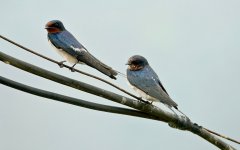
Asian Koels love the fruiting banyans that can be found in a few spots around the site. They're one of the birds that you really need for a big day list and inspiring when they sing - blaring out the familiar "Ko-ELL ... Ko-ELL" call they can be pretty easy, but they are much more difficult if not calling. Oriental Magpies are another resident that occurs in lower numbers and do not always shows when I'd like them to. Commoner that Red-billed Blue Magpie but significantly fewer in number than the 20-strong flocks of introduced Azure-winged Magpies they're another bird that rarely catches my attention. The one in this shot did for its grubby brown belly, and I was delighted when its head turned and I was able to separate the black eye from the black hood, making a subtle, but nicely logical focal point for an initially odd composition.
And lastly, not quite a resident, but certainly seen in almost every month of the year Common Kingfishers sometimes allow close enough approach to allow their full beauty to be captured. The two very different shots below show a bird hunting for a series of poles - also used for corralling fish, and the other a more intimate moment of a wonderfully tame bird perched above one of the lotus ponds I walk past on the way in from the road. Unfortunately I've lost the sharpness of the original in the cropping, but decided to retain it for showing thow different the change of angle and lighting makes it look from the other one.
Lastly, the truly resident Pied Kingfisher. I see them on pretty much every visit, but had never had more that three or four together anywhere in Hong Kong, so I was delighted to come across a gathering of six birds on the northwestern most fishpond on the site. The shot of six together was not a great picture so I'll post the somewhat better if not actually competent shot of five here.

Cheers
Mike
Many thanks for all the kind comments. I continue to cower on my sofa from the heat of a blistering May, but do have some shots of the commoner resident birds which i have not previously posted here.
First up, this newly fledged Plain Prinia jumped up right next me to in a stand of grass along one of the drainage channels. It's rare that I pay much attention to them as they are pretty common, but this one was not to be ignored and hung about for a few shots.

Another bird that often receives limited attention from me are the Barn Swallows. Rather than looking at them I usually search through them for Red-rumped Swallows, San Martins and and Asian House Martins and as such they'd be entitled to feel a little neglected. However they can be pretty approachable, sitting on low-hanging wires or the nets the fishpond operators use to concentrate the commercially sized fish. They also breed in the village and are here through most o the year so we gert a range of plumages from pristine to downright scruffy.

Asian Koels love the fruiting banyans that can be found in a few spots around the site. They're one of the birds that you really need for a big day list and inspiring when they sing - blaring out the familiar "Ko-ELL ... Ko-ELL" call they can be pretty easy, but they are much more difficult if not calling. Oriental Magpies are another resident that occurs in lower numbers and do not always shows when I'd like them to. Commoner that Red-billed Blue Magpie but significantly fewer in number than the 20-strong flocks of introduced Azure-winged Magpies they're another bird that rarely catches my attention. The one in this shot did for its grubby brown belly, and I was delighted when its head turned and I was able to separate the black eye from the black hood, making a subtle, but nicely logical focal point for an initially odd composition.
And lastly, not quite a resident, but certainly seen in almost every month of the year Common Kingfishers sometimes allow close enough approach to allow their full beauty to be captured. The two very different shots below show a bird hunting for a series of poles - also used for corralling fish, and the other a more intimate moment of a wonderfully tame bird perched above one of the lotus ponds I walk past on the way in from the road. Unfortunately I've lost the sharpness of the original in the cropping, but decided to retain it for showing thow different the change of angle and lighting makes it look from the other one.
Lastly, the truly resident Pied Kingfisher. I see them on pretty much every visit, but had never had more that three or four together anywhere in Hong Kong, so I was delighted to come across a gathering of six birds on the northwestern most fishpond on the site. The shot of six together was not a great picture so I'll post the somewhat better if not actually competent shot of five here.

Cheers
Mike
Last edited:
Owen Krout
Well-known member

Its a good thing to take the time to just appreciate the common blessings around us. TFS
Nice to see the common birds well and with appreciation! I'm always pleased to see the female Koel - and to get a nice pic is great. It's a nice comparison too to see the Kingfishers' coloration change with light direction. And wow - that's a lot of Pied Kingfishers - could it be a family?
MKinHK
Mike Kilburn

Whiskered and White-winged Terns

The big show-offs of April are the Whiskered and White-winged Terns. Very often hey focus their attention on a particular pond which means they give absolutely breathtaking views and they fly their feeding circuits, coming right up to or even over the edge of the pond. The Whiskered s are much more numerous, but on the day I failed connect with the Pectoral Sandpiper a group of eight White-winged Terns were hunting over the same pond as 20 or so Whiskered Terns, providing fine opportunity to improve my bird in flight photography skills.
Not to shabby - though I do say so myself!
Cheers
Mike

The big show-offs of April are the Whiskered and White-winged Terns. Very often hey focus their attention on a particular pond which means they give absolutely breathtaking views and they fly their feeding circuits, coming right up to or even over the edge of the pond. The Whiskered s are much more numerous, but on the day I failed connect with the Pectoral Sandpiper a group of eight White-winged Terns were hunting over the same pond as 20 or so Whiskered Terns, providing fine opportunity to improve my bird in flight photography skills.
Not to shabby - though I do say so myself!
Cheers
Mike
Owen Krout
Well-known member

That one must have had a case of it's eyes being bigger than what it could lift.  It looks like whatever it briefly snagged almost rolled him completely over! Good flying skills to have recovered from that one!
It looks like whatever it briefly snagged almost rolled him completely over! Good flying skills to have recovered from that one!
More optimistically, you have to try. Perhaps a miracle will happen.That one must have had a case of it's eyes being bigger than what it could lift.It looks like whatever it briefly snagged almost rolled him completely over! Good flying skills to have recovered from that one!
Having seen a Black Crowned Night Heron pulverize a rat weighting perhaps half their own against a rock here in NYCV, only then to swallow it whole,
I no longer squirm if a bird takes on something bigger. Birds are hot headed predators and sometimes it works out for them.
MKinHK
Mike Kilburn

After a baking hot summer with a few highlights - which I've reported elsewhere - my first visit back to San Tin since May offered a chance to reacquaint myself with fishpond birding. To be honest it was still baking hot - 33 degrees and 80-90% humidity, but it was October - and therefore there should migrants to be found!
I started well. The tree-lined lotus pond along the access road hid a slow-rattling flycatcher that was almost certainly a Red-breasted Flycatcher - tantalising as I've never had one on the patch before ! As I went round the back of the pond to find a Grey Wagtail in a side channel and a couple of Scarlet-backed Flowerpeckers overhead were nice scarcities, but the real star, which revealed itself with a flash of its lovely chestnut-tail was a showy Amur Paradise Flycatcher! Typically a bird of the forests it can turn up anywhere on migration and I was chuffed to make an early addition to the patch list. Other bits and pieces on the way in included distantly heard Azure-winged Magpies and Masked Laughingthrushes, Cinereous Tit and Common Tailorbird, Chinese and Crested Bulbuls, a female Oriental Magpie Robin, a couple of noisy Common Kingfishers and the first of many Little Grebes in the lotus pond, and an unseen takking Dusky Warbler - a welcome harbinger of autumn passage.
Going round the nearest ponds I was surprised to flush a long-tailed grey bird with a white wing bar amongst the Collared and Spotted Doves. as it landed and turned its head my excitement abated as the short crest and yellow and orange cheeks could only belong to an escaped Cockatiel! A second patch tick, but hardly one to get overexcited about. More interesting were my first Great Cormorants, Stejneger's Stonechats and Eastern Yellow Wagtails of the autumn, plus the first of what must have been a good 25 Black Drongos plus a nice spread of Common Sandpipers and a solitary juvenile Whiskered Tern which foraged briefly over the first pond by the road before disappearing until the end of my visit.
Having witnessed lots of grass cutting on the western side of the patch I was pleased to find the northeastern side much less disturbed. This area contributed the majority of the 15 Oriental Reed Warblers and five Black-browed Reed Warblers amongst which I search every year - and fruitlessly today - for the rarer accros. Its alway exciting to see if the brown torpedo zooming away above the pond to the next stand of grass is a short-winged, plain-faced Blunt-winged Warbler or if the gribbler in the reeds might pop up and show a weaker or even no black lateral crown stripe. Maybe this weekend if the weather lets up. In addition to these usual suspects there were four or five Zitting Cisticolas amongst the resident Plain and Yellow-bellied Prinias. The reeds can also hold buntings and other goodies, with today offering a couple of streaky-backed juvenile Yellow Bitterns a few White-breasted Waterhens and a couple of scruffy-looking juvenile Moorhens.
I was pleased to catch a flyover juvenile Purple Heron - I generally only see one or two a year here - to add to the loafing Grey Herons and the odd Black-crowned Night Heron and Chinese Pond Herons, as well as decent numbers of Great, Cattle and Little Egrets, plus a singleton Intermediate Egret, but it was presumably just a bit too early for the Black-faced Spoonbills to have arrived for the winter. The other good flyover was a high and silhouetted juvenile Pied Harrier - a bird I see most autumns on the patch, and shortly after a Black-winged Cuckooshrike popped out of a tree along the other side of the drainage channel and flashed the pale spot in its wings before dropping into the big banyan a little further along the ditch.
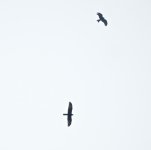
The northeastern corner held two pairs of Oriental Turtle Doves and a steady stream of Barn Swallows moving steadily westwards, but it was not until I was heading out on the far side of the patch that I picked up three Red Turtle Doves, which often gather in good numbers in this corner. I did however find a hepatic Plaintive Cuckoo to add to the Asian Koel and Greater Coucal that had shown well on the access road on arrival. A flyover Richard's Pipit and two Red-throated Pipits were both my first for this autumn.
Waders were a little thin on the ground with just a couple of Green Sandpipers among the usual Black-winged Stilts untilI came across a perfect drained pond in the middle of the patch with half the bottom still covered in water and some knee length grass both in and out of the water. This held a nice mix of waders, including a dozen Black-winged Stilts , five Pied Avocets, three Wood Sandpipers, two Marsh Sandpipers, three Little Ringed Plovers, four Common Snipes, a patch first Black-tailed Godwit, one each of Long-toed and Temminck's Stint and a couple of Red-necked Stints. Also lurking in the reeds was an unexpected mixed flock of dabbling ducks - in descending order of abundance four Eurasian Teal, three Northern Shoveler, two Wigeon and a Garganey.
Add to these the regular spread of Black-necked Starlings, Common and Crested Mynas, two Collared Crows, two Oriental Magpies, half a dozen Large-billed Crows and a smattering of Trees Sparrows, Amur Pied Wagtails and Spotted Munias, a couple of Long-tailed Shrikes, Pied and White-throated Kingfishers, the usual twenty or so Black Kites it took a distantly calling Taiga Flycatcher, buzzing much more rapidly in the trees near the tower in the Lok Ma Chau reserve than the slower rattle of the early unconfirmed Red-breasted Flycatcher, to bring my total to 79 species for the day.
Cheers
Mike
I started well. The tree-lined lotus pond along the access road hid a slow-rattling flycatcher that was almost certainly a Red-breasted Flycatcher - tantalising as I've never had one on the patch before ! As I went round the back of the pond to find a Grey Wagtail in a side channel and a couple of Scarlet-backed Flowerpeckers overhead were nice scarcities, but the real star, which revealed itself with a flash of its lovely chestnut-tail was a showy Amur Paradise Flycatcher! Typically a bird of the forests it can turn up anywhere on migration and I was chuffed to make an early addition to the patch list. Other bits and pieces on the way in included distantly heard Azure-winged Magpies and Masked Laughingthrushes, Cinereous Tit and Common Tailorbird, Chinese and Crested Bulbuls, a female Oriental Magpie Robin, a couple of noisy Common Kingfishers and the first of many Little Grebes in the lotus pond, and an unseen takking Dusky Warbler - a welcome harbinger of autumn passage.
Going round the nearest ponds I was surprised to flush a long-tailed grey bird with a white wing bar amongst the Collared and Spotted Doves. as it landed and turned its head my excitement abated as the short crest and yellow and orange cheeks could only belong to an escaped Cockatiel! A second patch tick, but hardly one to get overexcited about. More interesting were my first Great Cormorants, Stejneger's Stonechats and Eastern Yellow Wagtails of the autumn, plus the first of what must have been a good 25 Black Drongos plus a nice spread of Common Sandpipers and a solitary juvenile Whiskered Tern which foraged briefly over the first pond by the road before disappearing until the end of my visit.
Having witnessed lots of grass cutting on the western side of the patch I was pleased to find the northeastern side much less disturbed. This area contributed the majority of the 15 Oriental Reed Warblers and five Black-browed Reed Warblers amongst which I search every year - and fruitlessly today - for the rarer accros. Its alway exciting to see if the brown torpedo zooming away above the pond to the next stand of grass is a short-winged, plain-faced Blunt-winged Warbler or if the gribbler in the reeds might pop up and show a weaker or even no black lateral crown stripe. Maybe this weekend if the weather lets up. In addition to these usual suspects there were four or five Zitting Cisticolas amongst the resident Plain and Yellow-bellied Prinias. The reeds can also hold buntings and other goodies, with today offering a couple of streaky-backed juvenile Yellow Bitterns a few White-breasted Waterhens and a couple of scruffy-looking juvenile Moorhens.
I was pleased to catch a flyover juvenile Purple Heron - I generally only see one or two a year here - to add to the loafing Grey Herons and the odd Black-crowned Night Heron and Chinese Pond Herons, as well as decent numbers of Great, Cattle and Little Egrets, plus a singleton Intermediate Egret, but it was presumably just a bit too early for the Black-faced Spoonbills to have arrived for the winter. The other good flyover was a high and silhouetted juvenile Pied Harrier - a bird I see most autumns on the patch, and shortly after a Black-winged Cuckooshrike popped out of a tree along the other side of the drainage channel and flashed the pale spot in its wings before dropping into the big banyan a little further along the ditch.

The northeastern corner held two pairs of Oriental Turtle Doves and a steady stream of Barn Swallows moving steadily westwards, but it was not until I was heading out on the far side of the patch that I picked up three Red Turtle Doves, which often gather in good numbers in this corner. I did however find a hepatic Plaintive Cuckoo to add to the Asian Koel and Greater Coucal that had shown well on the access road on arrival. A flyover Richard's Pipit and two Red-throated Pipits were both my first for this autumn.
Waders were a little thin on the ground with just a couple of Green Sandpipers among the usual Black-winged Stilts untilI came across a perfect drained pond in the middle of the patch with half the bottom still covered in water and some knee length grass both in and out of the water. This held a nice mix of waders, including a dozen Black-winged Stilts , five Pied Avocets, three Wood Sandpipers, two Marsh Sandpipers, three Little Ringed Plovers, four Common Snipes, a patch first Black-tailed Godwit, one each of Long-toed and Temminck's Stint and a couple of Red-necked Stints. Also lurking in the reeds was an unexpected mixed flock of dabbling ducks - in descending order of abundance four Eurasian Teal, three Northern Shoveler, two Wigeon and a Garganey.
Add to these the regular spread of Black-necked Starlings, Common and Crested Mynas, two Collared Crows, two Oriental Magpies, half a dozen Large-billed Crows and a smattering of Trees Sparrows, Amur Pied Wagtails and Spotted Munias, a couple of Long-tailed Shrikes, Pied and White-throated Kingfishers, the usual twenty or so Black Kites it took a distantly calling Taiga Flycatcher, buzzing much more rapidly in the trees near the tower in the Lok Ma Chau reserve than the slower rattle of the early unconfirmed Red-breasted Flycatcher, to bring my total to 79 species for the day.
Cheers
Mike
Attachments
Last edited:
Owen Krout
Well-known member

Great stuff, Mike! Pickings have been pretty slim here so far. I keep hoping to make it back to HK for a couple of days of birding once travel restrictions ease off. Thailand and Vietnam were also on my list. Getting back into the Mainland is the big stumbling block right now.
MKinHK
Mike Kilburn

A fair bit of catching up from San Tin which I've now visited three times in the last ten days.
The last two visits were pretty hard work - the weather still pretty hot, despite the two minor typhoons, and the fire ant nests lurking in the grass like landmines. The typhoons were part of the problem - there was not a single drained ponds meaning that waders were few and far between, with he delightful exception of a sextet of Red-necked Phalaropes that were perfectly happy bobbing about one the verge of one of the ponds.
A tangle at the junction of two bunds produced a rather large, heavy-looking locustella that eventually revealed a heavily streaked back - confirming it as Pallas's Grasshopper Warbler, and that a smaller darker bird seen a little earlier was indeed a Lanceolated Warbler.
After another change in tenancy the eastern ponds beyond the drainage channel have again been abandoned, and today held an excellent four Purple Herons - two adult and two youngsters, plus an Eastern Marsh Harrier.But with the grass high and no drained ponds it was pretty hard work and I moved on after the fire ants struck - delivering six bites to my right leg. I did pick up the presumed breeding Oriental Turtle Doves in the northeast corner, and a fine male (albeit escaped) Yellow-crowned Bishop and the last of at least four Yellow Bitterns, which stared at me google-eyed from between the water hyacinths on the central drainage channel. was not until I was on my way out at the southwest corner that a trio of Red Turtle Doves, for which San Tin is the best site in Hong Kong, eventually delivered.
Other non-bird goodies on the day include my first Soft-shelled Turtle near the ponds where the Intermediate Egrets like to hang out, and just before the Red Turtle Doves a good-sized Common Ratsnake was sunning itself on a exposed mud bank.
Cheers
Mike
The last two visits were pretty hard work - the weather still pretty hot, despite the two minor typhoons, and the fire ant nests lurking in the grass like landmines. The typhoons were part of the problem - there was not a single drained ponds meaning that waders were few and far between, with he delightful exception of a sextet of Red-necked Phalaropes that were perfectly happy bobbing about one the verge of one of the ponds.
A tangle at the junction of two bunds produced a rather large, heavy-looking locustella that eventually revealed a heavily streaked back - confirming it as Pallas's Grasshopper Warbler, and that a smaller darker bird seen a little earlier was indeed a Lanceolated Warbler.
After another change in tenancy the eastern ponds beyond the drainage channel have again been abandoned, and today held an excellent four Purple Herons - two adult and two youngsters, plus an Eastern Marsh Harrier.But with the grass high and no drained ponds it was pretty hard work and I moved on after the fire ants struck - delivering six bites to my right leg. I did pick up the presumed breeding Oriental Turtle Doves in the northeast corner, and a fine male (albeit escaped) Yellow-crowned Bishop and the last of at least four Yellow Bitterns, which stared at me google-eyed from between the water hyacinths on the central drainage channel. was not until I was on my way out at the southwest corner that a trio of Red Turtle Doves, for which San Tin is the best site in Hong Kong, eventually delivered.
Other non-bird goodies on the day include my first Soft-shelled Turtle near the ponds where the Intermediate Egrets like to hang out, and just before the Red Turtle Doves a good-sized Common Ratsnake was sunning itself on a exposed mud bank.
Cheers
Mike
MKinHK
Mike Kilburn

Many thanks Tom - autumn its a great time to be birding at San Tin. Trouble is there's lots to write about and I'm now three visits behind. So here's the first of those - from 16th October two weeks ago.
I started with a Grey Heron perched photogenically in profile with one foot raised next to the flood alleviation pond. I've added another shot of Thursday's Great Egret, which, with the backdrop of a live fish transportation truck, a decaying duck house and a stack of containers, absolutely epitomises birding at San Tin
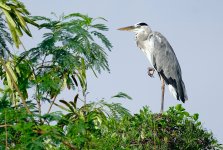
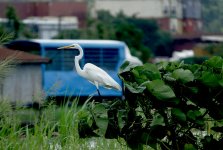
New birds from the previous visit included two flyover Oriental Pratincoles, while the 6 Red-necked Phalaropes and 160-odd Whiskered Terns remained, as did just two of the Purple Herons, as well as three Yellow Bitterns. Red Turtle Doves had increased to six, while passage of acros remained constant with 8 Oriental Reed Warblers and 6 Black-browed Reed Warblers, plus another single Pallas's Grasshopper Warbler.
an adult Black-winged Kite was a nice addition.
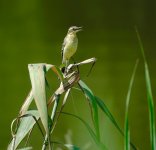

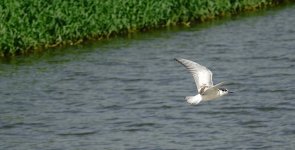
Cheers
Mike
I started with a Grey Heron perched photogenically in profile with one foot raised next to the flood alleviation pond. I've added another shot of Thursday's Great Egret, which, with the backdrop of a live fish transportation truck, a decaying duck house and a stack of containers, absolutely epitomises birding at San Tin


New birds from the previous visit included two flyover Oriental Pratincoles, while the 6 Red-necked Phalaropes and 160-odd Whiskered Terns remained, as did just two of the Purple Herons, as well as three Yellow Bitterns. Red Turtle Doves had increased to six, while passage of acros remained constant with 8 Oriental Reed Warblers and 6 Black-browed Reed Warblers, plus another single Pallas's Grasshopper Warbler.
an adult Black-winged Kite was a nice addition.



Cheers
Mike
MKinHK
Mike Kilburn

One week later on 24th October I was again at San Tin. While I would certainly have come anyway part of the reason for the visit was to search for the Siberian House Martin (the recently split eastern version of Common House Martin) that had been found the previous evening. It turned out that I had arrived too late, and not wanting to wait around with other birders in the hope of its return I again covered the northeastern part of the patch which held the first Coot and Eastern Buzzard of the autumn, as well as Purple Heron, and an Eastern Marsh Harrier, although I have to admit to becoming increasingly confused by these chocolate brown harriers at this time of year.
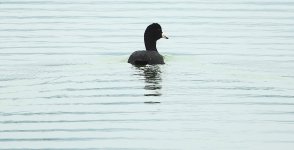
I was pleased to find a couple of hefty Chestnut-eared Buntings and five Yellow-breasted Buntings along one of the grassy tracks, as well as a dozen Pale Martins which were hunting low over the water - presumably where a chironomid hatching was in progress. I checked them multiple times over the course of the afternoon for the Siberian House Martin with no luck - and was annoyed to learn that it was seen again the next day.
While I was working out the buntings a WhatsApp message came through that a Red-headed Bunting had been found back where the Siberian House Martin had been seen. Rather than rushing over I decided to carry on birding the northeast side in the hope of finding something good for myself. There is one large triangular pond close to where the rickety bridge once stood which has often been productive, and as I headed over a Pallas's Grasshopper Warbler bounced briefly up before disappearing into cover and a second Coot showed in the Intermediate Egrets' favourite pond. Even better a large sandy-coloured passerine flushed almost from my feet as I reached the triangular pond and rather than disappearing over the horizon landed on top of a nearby weed, giving me the stink-eye for knocking it off its favourite feeding area.
Such birds are perfectly designed for my humble level of photography and I rattled off a few pix before putting the bins on what to me looked like a slam dunk for a juvenile Black-headed Bunting - albeit a rather pale one. Two or three of these turn up in Hong Kong most autumns, and I've been fortunate to find a few, which always requires careful consideration of whether the much rarer Red-headed Bunting can be safely eliminated.
This one had a fine collection of broad black streaks on the crown, a large bill and the "designed by a committee" jizz and gawky teenager awkwardness that completely endears them to me - while helpfully differentiating them from the neater, better constructed and more self-possessed Red-headed Bunting. And this bird was as awkward as they come, with a too-long tail, hunchback bulge on the nape and an unbrushed hedgehog haircut that was just brilliant! Mindful of the possibility of mistaken identity with a Red-headed Bunting claimed so close-by, I asked the finders to send me a pic, which confirmed that we had indeed seen the same bird, and that the additional angles I'd seen helped to confirm it as Black-headed. For those of you interested in a self-found list I claim this as a "self found" on the basis of securing the correct identification (see rule 6 in the link).
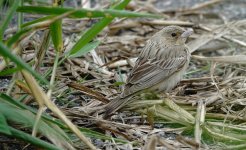
As I headed out I was pleased to pick up a circling raptor - which turned out to be a male Amur Falcon. Even though it was patch tick, it offered no competition whatsoever to the scruffy Black-headed Bunting as bird of the day.
Cheers
Mike

I was pleased to find a couple of hefty Chestnut-eared Buntings and five Yellow-breasted Buntings along one of the grassy tracks, as well as a dozen Pale Martins which were hunting low over the water - presumably where a chironomid hatching was in progress. I checked them multiple times over the course of the afternoon for the Siberian House Martin with no luck - and was annoyed to learn that it was seen again the next day.
While I was working out the buntings a WhatsApp message came through that a Red-headed Bunting had been found back where the Siberian House Martin had been seen. Rather than rushing over I decided to carry on birding the northeast side in the hope of finding something good for myself. There is one large triangular pond close to where the rickety bridge once stood which has often been productive, and as I headed over a Pallas's Grasshopper Warbler bounced briefly up before disappearing into cover and a second Coot showed in the Intermediate Egrets' favourite pond. Even better a large sandy-coloured passerine flushed almost from my feet as I reached the triangular pond and rather than disappearing over the horizon landed on top of a nearby weed, giving me the stink-eye for knocking it off its favourite feeding area.
Such birds are perfectly designed for my humble level of photography and I rattled off a few pix before putting the bins on what to me looked like a slam dunk for a juvenile Black-headed Bunting - albeit a rather pale one. Two or three of these turn up in Hong Kong most autumns, and I've been fortunate to find a few, which always requires careful consideration of whether the much rarer Red-headed Bunting can be safely eliminated.
This one had a fine collection of broad black streaks on the crown, a large bill and the "designed by a committee" jizz and gawky teenager awkwardness that completely endears them to me - while helpfully differentiating them from the neater, better constructed and more self-possessed Red-headed Bunting. And this bird was as awkward as they come, with a too-long tail, hunchback bulge on the nape and an unbrushed hedgehog haircut that was just brilliant! Mindful of the possibility of mistaken identity with a Red-headed Bunting claimed so close-by, I asked the finders to send me a pic, which confirmed that we had indeed seen the same bird, and that the additional angles I'd seen helped to confirm it as Black-headed. For those of you interested in a self-found list I claim this as a "self found" on the basis of securing the correct identification (see rule 6 in the link).

As I headed out I was pleased to pick up a circling raptor - which turned out to be a male Amur Falcon. Even though it was patch tick, it offered no competition whatsoever to the scruffy Black-headed Bunting as bird of the day.
Cheers
Mike
Attachments
Last edited:

All very nice indeed 👍
MKinHK
Mike Kilburn

Thanks Jos and Tom - This is peak season right now, and its a pleasure (mostly anyway, and more of that in due course) to be out with the distinct possibility of finding some good birds.
Saturday 31st October felt so birdy I made two visits to San Tin with an excellent chicken tikka biryani lunch at Shek Kong in between. Partly this was inspired by successfully twitching Hong Kong's second Lapland Bunting at San Tin, which I've covered in my Hong Kong Birding thread, and partly by feeling that I had not done the site justice before heading out for lunch.
Walking though San Tin village I picked up a couple of Sooty-headed Bubuls - a bird I only see three or four times a year here - and a Grey Wagtail lurking on the edge of a pond next to the alleviation pond with a juvenile Black-winged Stilt. A small group of six or seven Whiskered Terns suggested that passage was mostly done for this autumn - and that I should have made more effort to find a White-winged amongst them. But with plenty of other birds about and an embarrassment of choice for things to do it never quite made it to the top of the list. Three ocularis White Wagtails, including this handsome bird, were on the main track with a scattering of taivana Eastern Yellow Wagtails and the usual resident leucopsis Amur Wagtails.
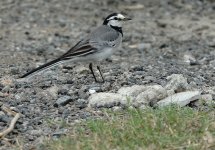
I again headed across the drainage channel to the northeastern side of the site, picking up 20-odd Red Turtle Doves and a female Eurasian Kestrel on the way in. Shortly after crossing the bridge and turning right I picked up two Eastern Buzzards which hopefully will join the Kestrel in residence for the whole winter. I have had good success in this corner of the patch in past years and was pleased to score nicely with three Yellow-breasted Buntings, a Northern Skylark and best of all a Wryneck on the track that heads towards the gate by the Main Drainage Channel (MDC). Sharing the scrubby fringes and tall grass were 20-odd Dusky Warblers, eight Black-browed Reed Warblers and a solitary Oriental Reed Warbler. I also picked up a nice male Chestnut-eared Bunting and a single Little Bunting, plus a couple of Eurasian Wigeon and the Black-winged Kite that has been around for a few months.
A handsome brown-backed Eastern Marsh Harrier with black-tipped grey wings that had me wondering about Western Marsh Harrier, but my impression of the bird in the field was roundly contradicted by shots from another birder. Ho Hum. Heading out I dodged a less than friendly dog and scrambled under the gate and found an unexpected immature Purple Heron on the MDC next to a group of 42 Black-winged Stilts. I heard but did not see a noisy gang of Red-billed Blue Magpies before heading off for lunch.
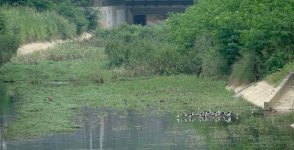
On my return I got dropped off right by the MDC gate, scuttled underneath and after pishing in a couple of Dusky Warblers and Black-browed Reed Warblers at the nearest corner thought it would be a good idea to go right round the Baer's Pochard Pond despite the bunds being covered by 6-foot hight grass with an 18-inch understory of dead grass. It was hard going but just about passable although not really productive - with just a couple of Stejneger's Stonechats, a Dusky Warbler and an immature Purple Heron being my scant reward for a ten minute bash where each step either got caught or required a weird sort of goose step to make progress.
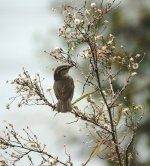
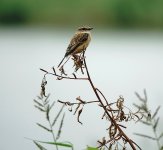
I knew from previous visits the bund had been cut with a six foot wide channel right at the far end, and believed I could cross it with dry feet by edging down one side of the bund. 0.4 seconds later I was lying face down with my feet above my head staring up at the grass-fringed sky with a few hundred grass seeds sticking to the suntan lotion all over my arms and face. It got better. Righting myself, my next step onto what I thought was dry ground put me in water up to my waist. With my phone now underwater I had to act fast and, determined not to go backwards, I lurched across the channel and dragged myself up through the equally tall grass on other side, having dunked the camera bag, my bins and myself up to the shoulders!
Finally back on level, Fire Ant-free ground I set about figuring out the damage and how on earth to dry myself and my kit. While the bins and phone were water resistant enough to survive, my five year old Sony RX10iii was not, and succumbed instantly. I also lost my water flask, and Kindle, and my wallet was a delightfully soggy mess. There was some compensation. While I stood there dripping a Lesser Coucal flew past me, perched photogenically in the grass on the other side of the channel that had just claimed me, and laughed at me. Despite the carnage my inner birder took over - it was a patch tick after all! - and I enjoyed great looks at the fine white pinstripes in the beautiful chestnut head breast and upperparts that readily identifies young birds from the larger Greater Coucal. It was only then, with my pockets hanging out to dry like elephant ears, that the Fire Ants struck; the little buggers getting a bite on each leg, while I only just in time got to one that had crawled all the way up my trouser leg and was on the verge of sinking its jaws into my stomach!
It did get better after that. I was too wet to get into a car or bus and decided to carry on birding in the hope that I would dry out a little, and decided to properly cover the parts of the patch which I hadn't yet reached in the last couple of hours before dark. My diligence was rewarded with a female Black-faced Bunting keeping company with a fine Yellow-breasted Bunting. Two Pallas's Grasshopper Warblers popped out of different tangles and a newly arrived flock of 70 Red Turtle Doves, plus a Peregrine that I was surprised ignored them, an Osprey, a Japanese Sparrowhawk that zipped through, terrorising the mixed flocks of Black-collared, Silky and White-shouldered Starlings that were gathering to roost. A big tree at the top end held a couple of Oriental Magpies and a flock of 60-odd White-cheeked Starlings. A Richard's Pipit flushed silently from a grassy bund and two Red-throated Pipits went over calling.
With the light starting to fade I was searching the skies for the Amur Falcons I hoped would drop in to roost, but I instead picked out a high and tight group of eight Black-faced Spoonbills just as they started their descent towards Mai Po - my first of the winter. Migration is always exciting, but even more so when you get to see it in action. These were clearly newly arriving migrants from either Korea or Tom's old stomping grounds on the Liaoning peninsula.
Back at ground level the furthest bund started producing buntings. First up were a couple of Yellow-breasted Buntings, then a smallish female Chestnut-eared Bunting that had enough of an eyering and gave brief enough views to have me dreaming of Grey-necked and Ortolans.
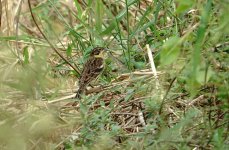
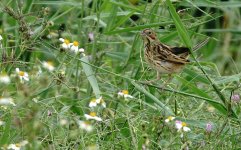
A second Chestnut-eared Bunting then flew, and with it a small, slim, pale and long-tailed bunting that immediately had me interested, and eventually revealed itself to be a spanking winter-plumaged male Pallas's Reed Bunting. It still had some of the dark hood, nicely set off by lovely pale underparts and nuchal collar, with a washed out black patch on the chin and throat and a fine suit of black streaks on the back. It clearly had full knowledge that my camera was trashed, and perched beautifully on a grass stem just a few metres away, giving absolutely stunning views - and fully justifying my decision to carry on birding. I was delighted to record five species of buntings at San Tin in a day, and with the Lapland Bunting at Long Valley making a sixth I had more than enough great birding to soften the blow of trashing the camera.
Cheers
Mike
Saturday 31st October felt so birdy I made two visits to San Tin with an excellent chicken tikka biryani lunch at Shek Kong in between. Partly this was inspired by successfully twitching Hong Kong's second Lapland Bunting at San Tin, which I've covered in my Hong Kong Birding thread, and partly by feeling that I had not done the site justice before heading out for lunch.
Walking though San Tin village I picked up a couple of Sooty-headed Bubuls - a bird I only see three or four times a year here - and a Grey Wagtail lurking on the edge of a pond next to the alleviation pond with a juvenile Black-winged Stilt. A small group of six or seven Whiskered Terns suggested that passage was mostly done for this autumn - and that I should have made more effort to find a White-winged amongst them. But with plenty of other birds about and an embarrassment of choice for things to do it never quite made it to the top of the list. Three ocularis White Wagtails, including this handsome bird, were on the main track with a scattering of taivana Eastern Yellow Wagtails and the usual resident leucopsis Amur Wagtails.

I again headed across the drainage channel to the northeastern side of the site, picking up 20-odd Red Turtle Doves and a female Eurasian Kestrel on the way in. Shortly after crossing the bridge and turning right I picked up two Eastern Buzzards which hopefully will join the Kestrel in residence for the whole winter. I have had good success in this corner of the patch in past years and was pleased to score nicely with three Yellow-breasted Buntings, a Northern Skylark and best of all a Wryneck on the track that heads towards the gate by the Main Drainage Channel (MDC). Sharing the scrubby fringes and tall grass were 20-odd Dusky Warblers, eight Black-browed Reed Warblers and a solitary Oriental Reed Warbler. I also picked up a nice male Chestnut-eared Bunting and a single Little Bunting, plus a couple of Eurasian Wigeon and the Black-winged Kite that has been around for a few months.
A handsome brown-backed Eastern Marsh Harrier with black-tipped grey wings that had me wondering about Western Marsh Harrier, but my impression of the bird in the field was roundly contradicted by shots from another birder. Ho Hum. Heading out I dodged a less than friendly dog and scrambled under the gate and found an unexpected immature Purple Heron on the MDC next to a group of 42 Black-winged Stilts. I heard but did not see a noisy gang of Red-billed Blue Magpies before heading off for lunch.

On my return I got dropped off right by the MDC gate, scuttled underneath and after pishing in a couple of Dusky Warblers and Black-browed Reed Warblers at the nearest corner thought it would be a good idea to go right round the Baer's Pochard Pond despite the bunds being covered by 6-foot hight grass with an 18-inch understory of dead grass. It was hard going but just about passable although not really productive - with just a couple of Stejneger's Stonechats, a Dusky Warbler and an immature Purple Heron being my scant reward for a ten minute bash where each step either got caught or required a weird sort of goose step to make progress.


I knew from previous visits the bund had been cut with a six foot wide channel right at the far end, and believed I could cross it with dry feet by edging down one side of the bund. 0.4 seconds later I was lying face down with my feet above my head staring up at the grass-fringed sky with a few hundred grass seeds sticking to the suntan lotion all over my arms and face. It got better. Righting myself, my next step onto what I thought was dry ground put me in water up to my waist. With my phone now underwater I had to act fast and, determined not to go backwards, I lurched across the channel and dragged myself up through the equally tall grass on other side, having dunked the camera bag, my bins and myself up to the shoulders!
Finally back on level, Fire Ant-free ground I set about figuring out the damage and how on earth to dry myself and my kit. While the bins and phone were water resistant enough to survive, my five year old Sony RX10iii was not, and succumbed instantly. I also lost my water flask, and Kindle, and my wallet was a delightfully soggy mess. There was some compensation. While I stood there dripping a Lesser Coucal flew past me, perched photogenically in the grass on the other side of the channel that had just claimed me, and laughed at me. Despite the carnage my inner birder took over - it was a patch tick after all! - and I enjoyed great looks at the fine white pinstripes in the beautiful chestnut head breast and upperparts that readily identifies young birds from the larger Greater Coucal. It was only then, with my pockets hanging out to dry like elephant ears, that the Fire Ants struck; the little buggers getting a bite on each leg, while I only just in time got to one that had crawled all the way up my trouser leg and was on the verge of sinking its jaws into my stomach!
It did get better after that. I was too wet to get into a car or bus and decided to carry on birding in the hope that I would dry out a little, and decided to properly cover the parts of the patch which I hadn't yet reached in the last couple of hours before dark. My diligence was rewarded with a female Black-faced Bunting keeping company with a fine Yellow-breasted Bunting. Two Pallas's Grasshopper Warblers popped out of different tangles and a newly arrived flock of 70 Red Turtle Doves, plus a Peregrine that I was surprised ignored them, an Osprey, a Japanese Sparrowhawk that zipped through, terrorising the mixed flocks of Black-collared, Silky and White-shouldered Starlings that were gathering to roost. A big tree at the top end held a couple of Oriental Magpies and a flock of 60-odd White-cheeked Starlings. A Richard's Pipit flushed silently from a grassy bund and two Red-throated Pipits went over calling.
With the light starting to fade I was searching the skies for the Amur Falcons I hoped would drop in to roost, but I instead picked out a high and tight group of eight Black-faced Spoonbills just as they started their descent towards Mai Po - my first of the winter. Migration is always exciting, but even more so when you get to see it in action. These were clearly newly arriving migrants from either Korea or Tom's old stomping grounds on the Liaoning peninsula.
Back at ground level the furthest bund started producing buntings. First up were a couple of Yellow-breasted Buntings, then a smallish female Chestnut-eared Bunting that had enough of an eyering and gave brief enough views to have me dreaming of Grey-necked and Ortolans.


A second Chestnut-eared Bunting then flew, and with it a small, slim, pale and long-tailed bunting that immediately had me interested, and eventually revealed itself to be a spanking winter-plumaged male Pallas's Reed Bunting. It still had some of the dark hood, nicely set off by lovely pale underparts and nuchal collar, with a washed out black patch on the chin and throat and a fine suit of black streaks on the back. It clearly had full knowledge that my camera was trashed, and perched beautifully on a grass stem just a few metres away, giving absolutely stunning views - and fully justifying my decision to carry on birding. I was delighted to record five species of buntings at San Tin in a day, and with the Lapland Bunting at Long Valley making a sixth I had more than enough great birding to soften the blow of trashing the camera.
Cheers
Mike
Last edited:
So nice that even in some of the most populated parts of China, some bits of nature remain.Thanks Jos and Tom - This is peak season right now, and its a pleasure (mostly anyway, and more of that in due course) to be out with the distinct possibility of finding some good birds.
Saturday 31st October felt so birdy I made two visits to San Tin with an excellent chicken tikka biryani lunch at Shek Kong in between. Partly this was inspired by successfully twitching Hong Kong's second Lapland Bunting at San Tin, which I've covered in my Hong Kong Birding thread, and partly by feeling that I had not done the site justice before heading out for lunch.
Walking though San Tin village I picked up a couple of Sooty-headed Bubuls - a bird I only see three or four times a year here - and a Grey Wagtail lurking on the edge of a pond next to the alleviation pond with a juvenile Black-winged Stilt. A small group of six or seven Whiskered Terns suggested that passage was mostly done for this autumn - and that I should have made more effort to find a White-winged amongst them. But with plenty of other birds about and an embarrassment of choice for things to do it never quite made it to the top of the list. Three ocularis White Wagtails, including this handsome bird, were on the main track with a scattering of taivana Eastern Yellow Wagtails and the usual resident leucopsis Amur Wagtails.
View attachment 1413417
I again headed across the drainage channel to the northeastern side of the site, picking up 20-odd Red Turtle Doves and a female Eurasian Kestrel on the way in. Shortly after crossing the bridge and turning right I picked up two Eastern Buzzards which hopefully will join the Kestrel in residence for the whole winter. I have had good success in this corner of the patch in past years and was pleased to score nicely with three Yellow-breasted Buntings, a Northern Skylark and best of all a Wryneck on the track that heads towards the gate by the Main Drainage Channel (MDC). Sharing the scrubby fringes and tall grass were 20-odd Dusky Warblers, eight Black-browed Reed Warblers and a solitary Oriental Reed Warbler. I also picked up a nice male Chestnut-eared Bunting and a single Little Bunting, plus a couple of Eurasian Wigeon and the Black-winged Kite that has been around for a few months.
A handsome brown-backed Eastern Marsh Harrier with black-tipped grey wings that had me wondering about Western Marsh Harrier, but my impression of the bird in the field was roundly contradicted by shots from another birder. Ho Hum. Heading out I dodged a less than friendly dog and scrambled under the gate and found an unexpected immature Purple Heron on the MDC next to a group of 42 Black-winged Stilts. I heard but did not see a noisy gang of Red-billed Blue Magpies before heading off for lunch.
View attachment 1413421
On my return I got dropped off right by the MDC gate, scuttled underneath and after pishing in a couple of Dusky Warblers and Black-browed Reed Warblers at the nearest corner thought it would be a good idea to go right round the Baer's Pochard Pond despite the bunds being covered by 6-foot hight grass with an 18-inch understory of dead grass. It was hard going but just about passable although not really productive - with just a couple of Stejneger's Stonechats, a Dusky Warbler and an immature Purple Heron being my scant reward for a ten minute bash where each step either got caught or required a weird sort of goose step to make progress.
View attachment 1413425 View attachment 1413426
I knew from previous visits the bund had been cut with a six foot wide channel right at the far end, and believed I could cross it with dry feet by edging down one side of the bund. 0.4 seconds later I was lying face down with my feet above my head staring up at the grass-fringed sky with a few hundred grass seeds sticking to the suntan lotion all over my arms and face. It got better. Righting myself, my next step onto what I thought was dry ground put me in water up to my waist. With my phone now underwater I had to act fast and, determined not to go backwards, I lurched across the channel and dragged myself up through the equally tall grass on other side, having dunked the camera bag, my bins and myself up to the shoulders!
Finally back on level, Fire Ant-free ground I set about figuring out the damage and how on earth to dry myself and my kit. While the bins and phone were water resistant enough to survive, my five year old Sony RX10iii was not, and succumbed instantly. I also lost my water flask, and Kindle, and my wallet was a delightfully soggy mess. There was some compensation. While I stood there dripping a Lesser Coucal flew past me, perched photogenically in the grass on the other side of the channel that had just claimed me, and laughed at me. Despite the carnage my inner birder took over - it was a patch tick after all! - and I enjoyed great looks at the fine white pinstripes in the beautiful chestnut head breast and upperparts that readily identifies young birds from the larger Greater Coucal. It was only then, with my pockets hanging out to dry like elephant ears, that the Fire Ants struck; the little buggers getting a bite on each leg, while I only just in time got to one that had crawled all the way up my trouser leg and was on the verge of sinking its jaws into my stomach!
It did get better after that. I was too wet to get into a car or bus and decided to carry on birding in the hope that I would dry out a little, and decided to properly cover the parts of the patch which I hadn't yet reached in the last couple of hours before dark. My diligence was rewarded with a female Black-faced Bunting keeping company with a fine Yellow-breasted Bunting. Two Pallas's Grasshopper Warblers popped out of different tangles and a newly arrived flock of 70 Red Turtle Doves, plus a Peregrine that I was surprised ignored them, an Osprey, a Japanese Sparrowhawk that zipped through, terrorising the mixed flocks of Black-collared, Silky and White-shouldered Starlings that were gathering to roost. A big tree at the top end held a couple of Oriental Magpies and a flock of 60-odd White-cheeked Starlings. A Richard's Pipit flushed silently from a grassy bund and two Red-throated Pipits went over calling.
With the light starting to fade I was searching the skies for the Amur Falcons I hoped would drop in to roost, but I instead picked out a high and tight group of eight Black-faced Spoonbills just as they started their descent towards Mai Po - my first of the winter. Migration is always exciting, but even more so when you get to see it in action. These were clearly newly arriving migrants from either Korea or Tom's old stomping grounds on the Liaoning peninsula.
Back at ground level the furthest bund started producing buntings. First up were a couple of Yellow-breasted Buntings, then a smallish female Chestnut-eared Bunting that had enough of an eyering and gave brief enough views to have me dreaming of Grey-necked and Ortolans.
View attachment 1413422 View attachment 1413423
A second Chestnut-eared Bunting then flew, and with it a small, slim, pale and long-tailed bunting that immediately had me interested, and eventually revealed itself to be a spanking winter-plumaged male Pallas's Reed Bunting. It still had some of the dark hood, nicely set off by lovely pale underparts and nuchal collar, with a washed out black patch on the chin and throat and a fine suit of black streaks on the back. It clearly had full knowledge that my camera was trashed, and perched beautifully on a grass stem just a few metres away, giving absolutely stunning views - and fully justifying my decision to carry on birding. I was delighted to record five species of buntings at San Tin in a day, and with the Lapland Bunting at Long Valley making a sixth I had more than enough great birding to soften the blow of trashing the camera.
Cheers
Mike
Just hope that TPTB recognize the treasures that are at their door.
China would be a lot happier if people spent their money to to look at their natural wonders instead of buying flats in an empty city.
MKinHK
Mike Kilburn

Happy to let you know that there is some recent good news about the Deep Bay fishponds from Hong Kong's most recent Policy Address etudiant.So nice that even in some of the most populated parts of China, some bits of nature remain.
Just hope that TPTB recognize the treasures that are at their door.
China would be a lot happier if people spent their money to to look at their natural wonders instead of buying flats in an empty city.
The link below outlines plans for developing the the northern parts of Hong Kong as a "Northern Metropolis". The key part is that the HK Government has proposed to turn the great majority of the fishponds into a contiguous 2,000 ha reserve made up of four nature parks. This area includes San Tin, as well as fishponds on either side of Mai Po. The first map shows the whole area and the second the detail which includes my patch at San Tin, which is labelled as Sam Po Shue Wetland Conservation Park.
As ever there is a bi gap between a policy statement and designated and properly managed park, but the intention is certainly encouraging.
Cheers
Mike
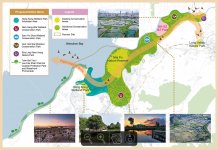
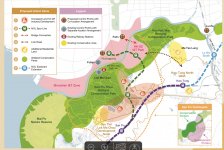
MKinHK
Mike Kilburn

An early start at the gate along the Main Drainage Channel yesterday offered early promise with a couple of Siberian Rubythroats calling from cover, along with the first Dusky Warblers, Stejneger's Stonechat, Black-faced Bunting and Black-browed Reed Warbler of the day. A measured rattling across the channels just too faint behind the calls of an overexcited flock of 40-odd Black-winged Stilts to confidently claim a Red-breasted Flycatcher.
There was a fair flow of traffic overhead, with a mix of all four regular Egret species heading east and 26 Eurasian Teals and even better 3 Chinese Spotbills with a regular trickle of Great Cormorants and a few Great Egrets heading back west. On entering the fishponds an Oriental Reed Warbler was scrambling in some weeds along with a very showy Black-browed Reed Warbler (the first of twenty or so)and the first of three Yellow-breasted Buntings and the dark Pied Harrier drifted low over the bunds.
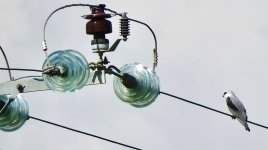
Ona pretty still morning activity was slowing down, with just singles of Black-faced and Chestnut-eared Buntings to add until the Black-winged Kite drifted over and even better my first Pheasant-tailed Jacana of the autumn came up from the grassy edge of the long pond flew north and then drifted back fishing its beautifully elegant black-edged white wings. Having had no Eurasian Greenshanks throughout October was delighted to see three birds- presumably migrants drop in the from the east and then find six more with a huddle of Black-winged Stilts. I was pleased to pick up first one and then a second Greater Spotted Eagle floating over the Lok Ma Chau reserve and distantly had two Eastern Buzzards towards the Lok Ma Chau hills.
A few other bits and pieces included three more Chestnut-eared Buntings, a calling Yellow-browed Warbler, a Sand Martin, a new high of five Coots, an adult Purple Heron, two flyover Swintail Snipe and a Common Snipe on the grassy edge of a fishpond.
Cheers
Mike
There was a fair flow of traffic overhead, with a mix of all four regular Egret species heading east and 26 Eurasian Teals and even better 3 Chinese Spotbills with a regular trickle of Great Cormorants and a few Great Egrets heading back west. On entering the fishponds an Oriental Reed Warbler was scrambling in some weeds along with a very showy Black-browed Reed Warbler (the first of twenty or so)and the first of three Yellow-breasted Buntings and the dark Pied Harrier drifted low over the bunds.

Ona pretty still morning activity was slowing down, with just singles of Black-faced and Chestnut-eared Buntings to add until the Black-winged Kite drifted over and even better my first Pheasant-tailed Jacana of the autumn came up from the grassy edge of the long pond flew north and then drifted back fishing its beautifully elegant black-edged white wings. Having had no Eurasian Greenshanks throughout October was delighted to see three birds- presumably migrants drop in the from the east and then find six more with a huddle of Black-winged Stilts. I was pleased to pick up first one and then a second Greater Spotted Eagle floating over the Lok Ma Chau reserve and distantly had two Eastern Buzzards towards the Lok Ma Chau hills.
A few other bits and pieces included three more Chestnut-eared Buntings, a calling Yellow-browed Warbler, a Sand Martin, a new high of five Coots, an adult Purple Heron, two flyover Swintail Snipe and a Common Snipe on the grassy edge of a fishpond.
Cheers
Mike
Users who are viewing this thread
Total: 2 (members: 0, guests: 2)





